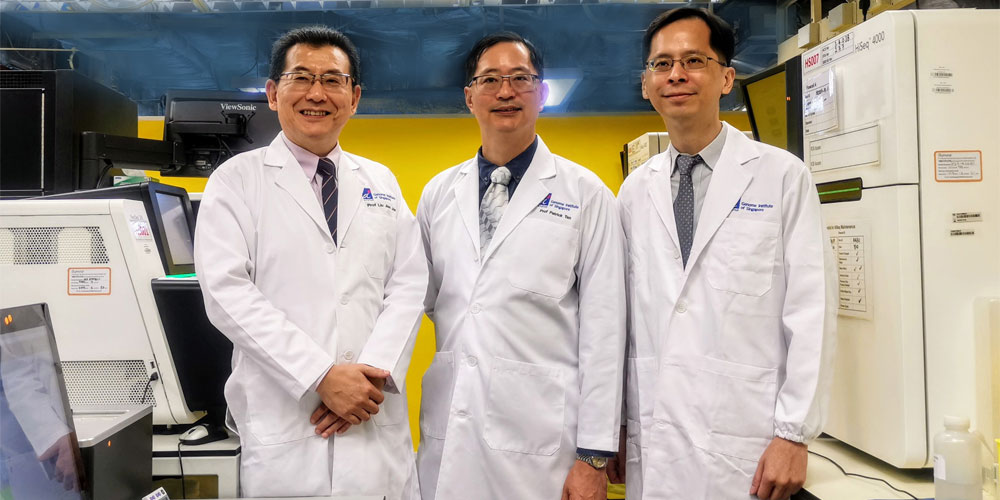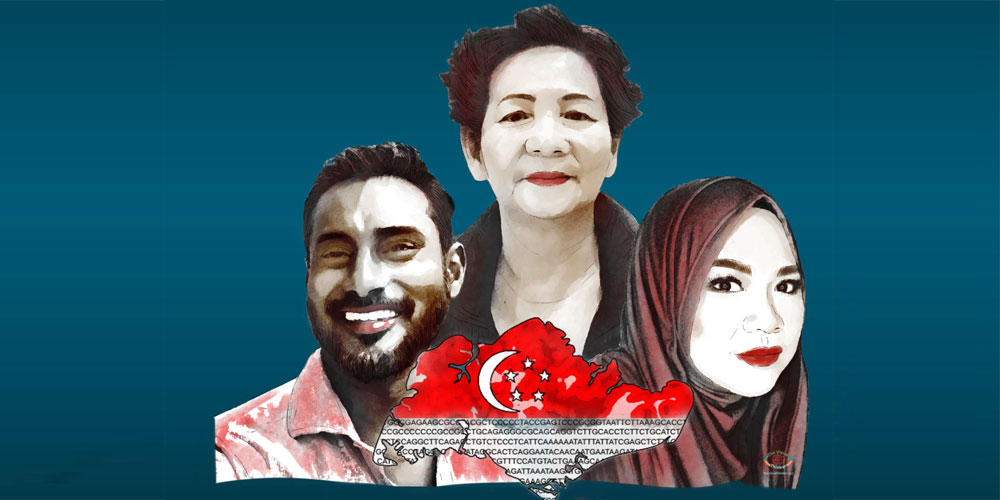A*STAR NEWS
Singapore completes world’s largest whole genome sequencing analysis of multi-ethnic Asian populations
Comprehensive genomic information of largely understudied Asian populations will expand understanding on the biology of diseases
SINGAPORE – A new genetic databank has been established containing the completed whole-genome sequencing (WGS) data of close to 5,000 Singaporeans. Worldwide, WGS is increasingly used in research and healthcare to identify genetic variations using cutting-edge technologies that allow large numbers of individuals to be sequenced rapidly – This new study is the world’s largest WGS analysis of Asian populations, particularly of Indian and Malay populations in the world, and provides valuable insights on the unique genetic diversity of Asian populations that could enable more accurate diagnosis of genetic diseases, empower the research of chronic diseases and guide prevention and targeted therapies. The study was published in Cell on 17 October 2019.
Genetic variation is known to contribute to an individual’s susceptibility to disease and response to treatments. Populations from different parts of the world show significant genetic diversity that is a consequence of their population histories. Asian populations are not extensively studied and their genetic make-up is poorly understood. These have hindered efforts to discover disease-associated genes that impact on the health of individuals from these populations.
Singapore provides an excellent representation of Asia. It consists of three major ethnic groups (Chinese, Malay, and Indian), which capture 80 per cent of Asia’s diversity. Hence, Singapore investigators performed WGS on close to 5,000 Singaporeans (2,780 Chinese, 903 Malays, and 1,127 Indians) over two years to establish a genetic reference on the local population for subsequent studies.
This study was a collaboration among scientists and clinicians from A*STAR’s Genome Institute of Singapore (GIS), National University Health System (NUHS), Singapore Eye Research Institute (SERI), Tan Tock Seng Hospital (TTSH), National Neuroscience Institute (NNI), Khoo Teck Puat Hospital (KTPH), National University Hospital (NUH), SingHealth Duke-NUS Institute of Precision Medicine (PRISM), National University of Singapore (NUS) and Singapore General Hospital (SGH).
Study findings
The study revealed a noticeable degree of genetic intermingling among the three ethnic groups, of which Chinese and Malays are more closely related. It suggests that Malays split from Chinese about 24,800 years ago and experienced significant gene inflow with East Asians about 1,700 years ago, coinciding with the Austronesian expansion, a hypothesized historical migration of peoples from Taiwan/East Asia to Southeast Asia and further to remote Pacific and Oceania islands.
In addition, the team identified 98.3 million genetic variants across the Singapore genomes. Of these more than half have not been previously reported in public databases, which to date have focused on Western and European populations. It also identified 20 candidate loci for natural selection where genome sequences were altered as a result of survival and adaptation to local environments during human evolution. 14 loci were found to be associated with human traits and diseases. This may explain why certain diseases and human traits, such as ALDH2 deficiency (Asian Flush), are more or less common in Asians. These results show the relevance and utility of performing genetic studies across diverse populations in Asia.
Professor Liu Jianjun, Deputy Executive Director at GIS and Professor at Yong Loo Lin School of Medicine, National University of Singapore, said, “The study provides comprehensive genetic information and resources on both local Singapore and Asian populations. This will empower research that will help us understand the inherited basis of diseases in Asian populations, that could result in the development of new treatments and ways to predict and diagnose diseases.”
Professor Tai E Shyong, Professor at Yong Loo Lin School of Medicine and Saw Swee Hock School of Public Health, National University of Singapore, as well as Senior Consultant at the Division of Endocrinology, University Medicine Cluster, and Lead of the Metabolic Disease Summit Research Programme at the National University Health System, said, “The history of Singapore, and its peoples, has created a rich multi-ethnic population and unique opportunities to carry out research to improve health. These novel variants present a unique opportunity to make observations that cannot be made in other populations, where these variants are not present. In turn, these observations allow us to develop new ways to predict diseases, and, potentially, identify new ways to treat or prevent them.” Professor Tai has also conducted numerous genetic association studies to better understand the cause of type 2 diabetes, obesity, hypertension and high cholesterol.
Professor Patrick Tan, Executive Director at GIS, Director at SingHealth Duke-NUS Institute of Precision Medicine (PRISM), and Professor at Duke-NUS Medical School, said, “The project provides a pilot genetic map of Asian populations that allows us to measure precisely the genetic contribution to disease, and combine it with other sources of data within a data-driven healthcare system. Potentially, this will provide insights to prevent disease before it occurs, diagnose disease earlier, and ensure that therapies are deployed in a way that maximises clinical benefits while minimising adverse effects. This will benefit both Singapore and the Asian population at large by providing more effective and efficient healthcare services.”
About A*STAR’s Genome Institute of Singapore (GIS)
The Genome Institute of Singapore (GIS) is an institute of the Agency for Science, Technology and Research (A*STAR). It has a global vision that seeks to use genomic sciences to achieve extraordinary improvements in human health and public prosperity. Established in 2000 as a centre for genomic discovery, the GIS will pursue the integration of technology, genetics and biology towards academic, economic and societal impact.
The key research areas at the GIS include Human Genetics, Infectious Diseases, Cancer Therapeutics and Stratified Oncology, Stem Cell and Regenerative Biology, Cancer Stem Cell Biology, Computational and Systems Biology, and Translational Research.
The genomics infrastructure at the GIS is utilised to train new scientific talent, to function as a bridge for academic and industrial research, and to explore scientific questions of high impact.
For more information about GIS, please visit www.a-star.edu.sg/gis.
About the Agency for Science, Technology and Research (A*STAR)
The Agency for Science, Technology and Research (A*STAR) is Singapore's lead public sector agency that spearheads economic oriented research to advance scientific discovery and develop innovative technology. Through open innovation, we collaborate with our partners in both the public and private sectors to benefit society.
As a Science and Technology Organisation, A*STAR bridges the gap between academia and industry. Our research creates economic growth and jobs for Singapore, and enhances lives by contributing to societal benefits such as improving outcomes in healthcare, urban living, and sustainability.
We play a key role in nurturing and developing a diversity of talent and leaders in our Agency and research entities, the wider research community and industry. A*STAR’s R&D activities span biomedical sciences and physical sciences and engineering, with research entities primarily located in Biopolis and Fusionopolis. For ongoing news, visit www.a-star.edu.sg.
Annex A
IMAGES

Three of the authors from the study published in Cell, from left: Prof Liu Jianjun (Deputy Executive Director of GIS, and Professor at Yong Loo Lin School of Medicine, NUS), Prof Patrick Tan (Executive Director of GIS, and Director of SingHealth Duke-NUS Institute of Precision Medicine, PRISM), and Prof Cheng Ching-Yu (Principal Clinician Scientist at the Singapore Eye Research Institute, representing the study’s participating cohorts).

Singapore’s three major ethnic groups – Indian, Chinese, and Malay.
(Illustration by Gloria Fuentes - The Visual Thinker LLP).
Annex B
Notes to Editor:
The research findings described in this media release can be found in the scientific journal Cell, under the title, “Large-scale whole-genome sequencing of three diverse Asian populations in Singapore” by Degang Wu1,2,39, Jinzhuang Dou 1,3,39, Xiaoran Chai1, 39, Claire Bellis4,5, Andreas Wilm6, Chih Chuan Shih6, Wendy Wei Jia Soon7, Nicolas Bertin1, Clarabelle Bitong Lin4, Chiea Chuen Khor4, Michael DeGiorgio8, Shanshan Cheng2, Li Bao2, Neerja Karnani9,10, William Ying Khee Hwang11,12, Sonia Davila13,14, Patrick Tan13,15,16,17, Asim Shabbir18, Angela Moh 19<, Eng-King Tan20,21, Jia Nee Foo4,22, Liuh Ling Goh23, Khai Pang Leong24, Roger S.Y. Foo4,25,26, Carolyn Su Ping Lam27,28,25,29,30, Arthur Mark Richards25,26,31, Ching-Yu Cheng32,33,34, Tin Aung32,33,34, Tien Yin Wong32,33,34, Huck Hui Ng10,35,36,37, Jianjun Liu4,26,*, and Chaolong Wang2,1,40,* on behalf of the SG10K Consortium38.
- 1. Computational and Systems Biology, Genome Institute of Singapore, Agency for Science, Technology and Research, Singapore 138672, Singapore
- 2. Department of Epidemiology and Biostatistics, School of Public Health, Tongji Medical College, Huazhong University of Science and Technology, Wuhan, Hubei 430030, China
- 3. Department of Bioinformatics and Computational Biology, Division of Quantitative Sciences, The University of Texas MD Anderson Cancer Center, Houston, TX 77030, USA
- 4. Human Genetics, Genome Institute of Singapore, Agency for Science, Technology and Research, Singapore 138672, Singapore
- 5. Genomics Research Centre, Institute of Health and Biomedical Innovation, Queensland University of Technology, Brisbane 4000, Australia
- 6. Bioinformatics Core, Genome Institute of Singapore, Agency for Science, Technology and Research, Singapore 138672, Singapore
- 7. Integrated Genome Analysis Platform (iGAP), Genome Institute of Singapore, Agency for Science, Technology and Research, Singapore 138672, Singapore
- 8. Department of Computer and Electrical Engineering and Computer Science, Florida Atlantic University, Boca Raton, FL 33431, USA
- 9. Singapore Institute for Clinical Sciences, Agency for Science, Technology and Research, Singapore 117609, Singapore
- 10. Department of Biochemistry, Yong Loo Lin School of Medicine, National University of Singapore, Singapore 117597, Singapore
- 11. Department of Haematology, Singapore General Hospital, Singapore 169608, Singapore
- 12. National Cancer Centre Singapore, Singapore, 169610, Singapore
- 13. SingHealth Duke-NUS Institute of Precision Medicine, Singapore 169856, Singapore
- 14. Cardiovascular and Metabolic Disorders Program, Duke-NUS Medical School, Singapore 169857, Singapore
- 15. Cancer and Stem Biology Program, Duke-NUS Medical School, Singapore 169857, Singapore
- 16. Cancer Science Institute of Singapore, National University of Singapore, Singapore 117599, Singapore
- 17. Genome Institute of Singapore, Agency for Science, Technology and Research, Singapore 138672, Singapore
- 18. Department of Surgery, National University Health System, Singapore 119228, Singapore
- 19. Clinical Research Unit, Khoo Teck Puat Hospital, Singapore 768828, Singapore
- 20. Department of Neurology, National Neuroscience Institute, Singapore General Hospital Campus, Singapore 169608, Singapore
- 21. Neuroscience and Behavioural Disorders Program, Duke-NUS Medical School, Singapore 169857, Singapore
- 22. Lee Kong Chian School of Medicine, Nanyang Technological University, Singapore 308232, Singapore
- 23. Personalised Medicine Service, Tan Tock Seng Hospital, Singapore 308433, Singapore
- 24. Clinical Research and Innovation Office, Tan Tock Seng Hospital, Singapore 308433, Singapore
- 25. Cardiovascular Research Institute, National University Heart Centre, Singapore 119074, Singapore
- 26. Department of Medicine, Yong Loo Lin School of Medicine, National University of Singapore, Singapore 117597, Singapore
- 27. Department of Cardiology, National Heart Centre Singapore, Singapore 169609, Singapore
- 28. Cardiovascular Sciences Academic Clinical Program, Duke-NUS Medical School, Singapore 169857, Singapore
- 29. Department of Cardiology, University Medical Center Groningen, Groningen 9713GZ, the Netherlands
- 30. The George Institute for Global Health, Newtown NSW 2042, Australia
- 31. Christchurch Heart Institute, University of Otago, Christchurch 8011, New Zealand
- 32. Singapore Eye Research Institute, Singapore National Eye Centre, Singapore 169856, Singapore
- 33. Ophthalmology & Visual Sciences Academic Clinical Program (Eye ACP), Duke-NUS Medical School, Singapore 169857, Singapore
- 34. Department of Ophthalmology, Yong Loo Lin School of Medicine, National University of Singapore, Singapore 117597, Singapore
- 35. Stem Cell and Regenerative Biology, Genome Institute of Singapore, Agency for Science, Technology and Research, Singapore 138672
- 36. Department of Biological Sciences, National University of Singapore, Singapore 117558, Singapore
- 37. School of Biological Sciences, Nanyang Technological University, Singapore 637551, Singapore
- 38. Affiliations of additional authors of the SG10K Consortium were listed in the Supplemental Note
- 39. These authors contributed equally
- 40. Lead Contact
* Correspondence: Liu Jianjun (liuj3@gis.a-star.edu.sg)
Was This Article Helpful ?
A*STAR celebrates International Women's Day

From groundbreaking discoveries to cutting-edge research, our researchers are empowering the next generation of female science, technology, engineering and mathematics (STEM) leaders.
Get inspired by our #WomeninSTEM
